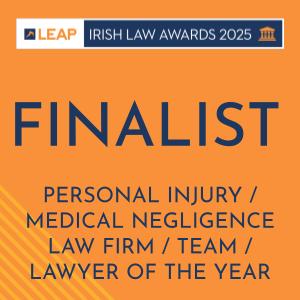Claims arising from Cerebral Palsy
Birth injury cases for children with cerebral palsy are among the most difficult and distressing that come before the Courts in Ireland.
Cerebral palsy is a term used for neurological conditions affecting a child’s movement, which can be caused by complications before, during or soon after delivery. Sometimes, those birth complications can either be caused or contributed to if there was a mismanagement of the medical care provided. A medical negligence claim may be brought on behalf of a child who developed cerebral palsy as a result of a mismanagement of the obstetric care that the mother received and/or the neonatal care received by the infant.
Types of Cerebral Palsy
There are 3 main types of cerebral palsy:
1. Spastic cerebral palsy:
Where children have muscle stiffness and muscle weakness, which affects their range of movement. Limbs can be affected on both sides of the body or only one side. It is the most common form, affecting up to 80% of people with cerebral palsy and it is caused by damage to the motor cortex.
2. Dyskinetic cerebral palsy (sometimes referred to as dystonic, athetoid or choreoathetoid):
Where children tend to make involuntary movements because they find it difficult to control their muscles which change from floppy to tense. Speech and hearing may also be affected. This is the result of damage to the basal ganglia in the brain.
3. Ataxic cerebral palsy:
Where children find balance difficult and their movements are uncoordinated. Speech may be irregular and hand movements may be shaky. This is as a result of damage to the cerebellum.
It is not uncommon for people with cerebral palsy to have a combination of two or more of these types and they may also have sensory impairment and neurocognitive and neurobehavioral issues.
Causes of Cerebral Palsy
In the great majority of cases, a child’s cerebral palsy was not caused by their birth, however, cerebral palsy can result from events during the delivery process and early neonatal period
Complications that can cause cerebral palsy include:
- lack of or limited oxygen supply to the brain (HIE, hypoxia, asphyxia)
- a bleed within the brain
- placental abruption
- a difficult or premature birth
- the mother suffering from an infection during the pregnancy
- a failure of a medical professional to diagnose maternal conditions during pregnancy e.g. gestational diabetes
Hypoxic Ischemic Encephalopathy (HIE):
A neonatal brain injury caused by oxygen deprivation and limited blood flow to the baby’s brain at or near the time of its birth. Cell death and subsequent brain damage occur when the brain does not receive adequate oxygenation. It is estimated that about 9 – 10% of cases of cerebral palsy is caused by HIE.
HIE can be managed by neonatal therapeutic hypothermia treatment (cooling treatment). The baby’s head or body is cooled down to slow the spread of the damage within the cells of the brain. This helps the baby’s brain to recover and minimise the level of disability the child may have as they develop.
Immediate Tests for Distress in Neonatal Period
Apgar Scores:
The Apgar scores taken in the moments after a baby’s birth are also an important indicator as to whether the baby has suffered a birth injury. These scores are carried out by the medical staff at one minute, five minutes and ten minutes after birth and record colour, pulse, grimace, movement and first breath. If the baby’s AGPAR score is still low at 5 minutes, this can be a sign of HIE as are seizures and a necessity for resuscitation.
Umbilical Cord Blood Gases:
One of the most reliable ways of finding out if a baby has suffered a lack of oxygen is through an umbilical cord blood test immediately after its birth. When a baby has suffered a deprivation of oxygen, there will be an abnormally high level of acid in the blood sample from the umbilical artery.
Legal Test for Medical Negligence & Cerebral Palsy
If your child has suffered cerebral palsy as a result of alleged medical negligence, your legal team must be able to prove the following:
1. Breach of duty
i) That there a breach of the duty of care owed by the medical practitioner, and
ii) That breach of duty caused the injury in question.
2. That the medical practitioner in question is proved guilty of such failure – that no medical practitioner of equal specialist or general status and skill would be guilty of, if acting with ordinary care
This may include failures to:
- deliver a baby quickly enough or perform a caesarean section
- appropriately monitor the baby’s heartbeat and correctly interpret and monitor decelerations on the CTG trace
- appropriately administer Oxytocin/ Syntocinon used to induce or accelerate labour
- respond appropriately to the umbilical cord being caught around the baby’s neck
- diagnose conditions such vasa previa and pre-eclampsia during pregnancy
- treat avoidable infection caught by a mother during pregnancy
- provide proper treatment to the baby once it has been born
- competently perform resuscitation and/or manage ventilation of the baby after birth
- diagnose and competently treat hypoglycaemia in the newborn baby
- provide neonatal therapeutic hypothermia (otherwise known as cooling treatment)
How a Claim is Brought
1. Establishing Liability & Causation:
Your solicitor will obtain at least one medical expert report to establish whether the injury arose as a result of the hospital’s or care provider’s negligence. The speciality of the medical expert will depend on the nature of the injury. You may require multiple reports from a range of doctors including an obstetrician, a neuroradiologist and a neonatologist.
2. Issuing Proceedings:
Once your solicitors have obtained at least one supportive liability and causation report, they can issue court proceedings. Proceedings for catastrophic birth injury claims are typically issued in the High Court. Birth injury claims can be brought by a parent of the child, acting as a ‘next friend’ up until the child’s 18th birthday. Thereafter, the individual has two years to bring a birth injury claim in their own right. The person bringing the claim is called the Plaintiff.
3. Medical Reports:
Your solicitor will obtain medical reports from the child’s treating doctors, for example from the GP, paediatric neurologist and rehabilitation consultant. These reports are obtained for the purpose of detailing the child’s current condition and future prognosis, from a medical perspective.
4. Quantum Reports:
The third category of reports is what is referred to as quantum reports. These are the reports which your solicitors will use for the purpose of calculating the bulk of the value of the claim for compensation. Your solicitors will instruct a number of experts to assess the child’s current needs and what their needs will look like moving into the future.
Quantum experts can include physiotherapists, occupational therapists, care consultants, speech & language therapists, housing experts, assistive technology experts, vocational assessors, psychologists and rehabilitation consultants. Those experts will make a number of recommendations to help the child live a more independent life in the future.
Finally, an actuary will review all of those quantum reports to calculate the total value of those future recommendations.
The costs that have been built up to date will also be included in the claim. For example, the cost of making any adaptions to the child’s home will be included and additionally, the hours put in by loved ones caring for the child will be valued.
5. Offer/Award:
If you have been successful with your claim for compensation, then the child may receive a lump sum payment or an interim settlement or periodic payments. Although the courts are currently not disposed to making periodic payments, your solicitor can engage an expert to secure their view on this point.
If the injured party is now an adult, who has full mental capacity, then he/she spend the money how they see fit.
If the injured party is under the age of 18, then the funds are typically lodged in the High Court until the child turns 18 years. In the meantime, the child’s next friend (e.g. parent/guardian) will be permitted to take out monies to cover the child’s expenses on a monthly basis and also make big purchases for housing and equipment.
Specialist Birth Injury Solicitors
If you believe that you might have a medical negligence claim relating to cerebral palsy, it is important that you choose specialist medical negligence solicitors to handle your case.
We at McMahon Goldrick Solicitors, specialise in acting on behalf of children who have sustained birth injuries caused by medical negligence. We are the only firm in Ireland to exclusively specialise in representing clients who have sustained birth, brain & spinal injuries.
Due to the small & specialist nature of our firm, we have the ability to spend the necessary time to do a thorough examination of the medical records in a potential new birth injury matter and we continuously educate ourselves on the new & emerging recommended best obstetric & neonatal care practices
If you would like any further information on cerebral palsy claims, please feel free to call or email us any time.




